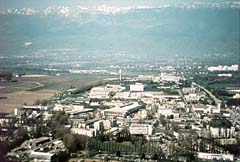NewMedia History : is it that new (7) ?
CERN laboratory, Geneva, Switzerland |
Tim Berners-Lee | World Wide Web <1989>"An important part is the integration of a hypertext
system with existing data, so as to provide a universal system, and to
achieve
|
In 1989 Tim Berners-Lee, a young British engineer working at CERN, the particle physics laboratory in Geneva, Switzerland, circulated a proposal for an in-house on-line document sharing system which he described modestly as "a 'web' of notes with links." After getting a grudging go-ahead from his superiors, Berners-Lee dubbed this system the World Wide Web. The Web, as he designed it, combined the communications language of the Internet with Nelson's hypertext and hypermedia, enabling links between files to extend across a global network. It became possible to link every document, sound file or graphic on the Web in an infinite variety of non-linear paths through the network. And instead of being created by a single author, links could be written by anyone participating in the system. Not only did the open nature of the Web lend itself to a wide array of interactive, multimedia experiences, but by hewing to a non-hierarchical structure and open protocols, Berners-Lee's invention became enormously popular, and led to an explosion in the creation of multimedia. By 1993 the Web had truly become an international phenomenon.
Source : http://www.artmuseum.net/w2vr/timeline/BernersLee.html
